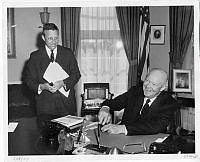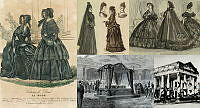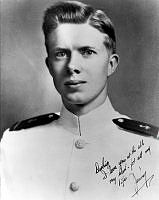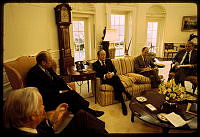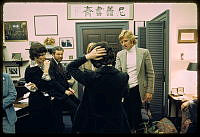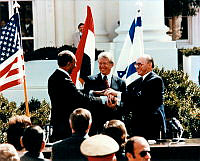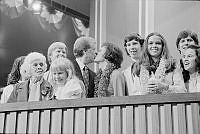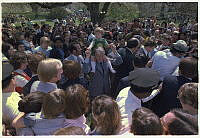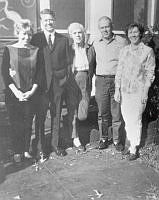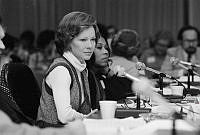Frances Folsom Cleveland's White House Wardrobe
Copyright © Fall 2012 White House Historical Association. All rights reserved under international copyright conventions. No part of this article may be reproduced or utilized in any form or by any means, electronic or mechanical, including photocopying, recording, or by any information storage and retrieval system, without permission in writing from the publisher. Requests for reprint permissions should be addressed to books@whha.org
President Grover Cleveland was ill-prepared for the American sovereigns’ (as he referred to the public) fascination with his soon-to-be-bride when he formally announced their upcoming nuptials on May 28, 1886. In an era in which people obtained their news in print, occasionally with the aid of an artist’s sketch, word traveled rapidly about the unusual beauty of Frances Folsom, Cleveland’s 21-year-old, dark-haired, blue-eyed fiance. Her appearance at a Decoration Day Parade in New York City, on May 31, revealed a statuesque, poised, and self-possessed woman with an eye for fashion and a figure on which the era’s styles fit well. She wore a gray suit, described by several newspapers as “tailor-made,” with a fitted jacket and high collar, and a black straw hat adorned with a grayish white feather.1
Just fourteen months earlier, in March 1885, reporters had dismissed the then 20-year-old college student as a “young schoolgirl” when describing her appearance at a White House reception held by Cleveland’s sister, Rose, who was serving as his hostess. Her dress, “simple, made of white nun’s veiling and surah, with a cascade of lace around the waist and skirt,” was neither especially eye-catching nor remarkable.2

Frances Folsom Cleveland on her wedding day in 1886, dressed to descend the stairs, posed for this photograph to show her wedding gown and its orange blossom and laurel trimmings.
Library of CongressNow the “schoolgirl” was the president’s bride. Everyone was interested in the details of her wedding gown, and she did not disappoint her would-be admirers. “Accustomed as were the ladies gathered in the Blue Room to the dazzle of rich costumes, they could barely restrain expressions of wonder and admiration at the beautiful picture presented by the bride,” the New York Times reported on the day following the June 2 ceremony.3 The wedding dress, constructed of satin, silk, and fine muslin, was characterized as elegant and charming. The skirt of heavy, ivory satin was reported to be stiff enough to stand alone. It was, in fact, stiffened with buckram at the hem and reinforced with a clever series of bone stays that, when fastened, created a birdcage bustle effect.4
A soft Indian muslin silk jupe (jacket) draped at the waist. The bodice, of the same heavy satin fabric as the skirt, crossed from left to right and fastened at the hip. The sleeves reached just below the bride’s elbows, where they met her gloves. Two filmy muslin scarves were attached at the shoulder seams, crisscrossed the bodice, and fastened at the hip. A satin dickey with a low collar fit neatly inside the V of the bodice. The veil, constructed of tulle, was more than 6 yards long. The train was rounded at the hem and was attached by handstitching to the back of the bodice.5
Now the “schoolgirl” was the president’s bride. Everyone was interested in the details of her wedding gown, and she did not disappoint her would-be admirers.
The gown was heavily ornamented with orange blossoms, made popular by Queen Victoria, who had intertwined them in her bridal wreath when she married Prince Albert in 1840. The blossoms of Frances Folsom’s gown were sewn along the cross-seam of both the bodice and the skirt, as well as along the hem of the jupe. Orange blossoms and leaves were attached at points that were formed by the hem of the sleeve at the elbow, and the flowers and myrtle were intertwined in the veil.6
The dressmaker’s tag is no longer in the gown, but it is believed that it was designed by Maison Worth of Paris. Miss Folsom had traveled to Europe with her mother and cousin in October 1885, returning the day before the official wedding announcement. According to her correspondence, she spent considerable time in France and Italy, and her trunks contained a full trousseau. A few remaining artifacts of her clothing contain the label from that well-recognized couturier, so the speculation is not unreasonable.

Frances Folsom’s dress of ivory satin, which her attendants said could “stand up by itself,” must have made quite a picture framed in Tiffany’s iridescent blues, snowfalls of white, and silver reflectors for the gas wall lamps that constituted the decor of the Blue Room.
Library of CongressMaison Worth was the dominant Parisian fashion house of its time, and its founder, the English-born Charles Frederick Worth, played a leading role in determining women’s styles and fabrics for nearly a century, from the late 1850s until the merger of the house, through management by his sons, with another Parisian couturier, Jeanne Paquin, in 1953. Worth gained favor with the court of Napoleon III and opened the Maison Worth in 1858. Worth’s clothes were sought after by royals and aristocrats and some of his most devoted patrons were the wives and daughters of America’s industrial tycoons. His elegant costumes were considered the “gold standard” for his clientele, and they were distinguished by his specially commissioned textiles. Worth artfully cut the fabric and matched seams in such a way as to maximize the impact of texture and pattern.7
Worth’s signature style was to integrate textures and fabrics. In an era when darker, monochromatic grays, browns, and dark greens were the usual fashion palette, he experimented with color variations of light and dark fabrics and favored reds, pinks, and lavenders. Worth embellished his designs with embroidery, tassels, sequins, seed pearls, and beads.
Mrs. Cleveland’s tastes mirrored the famed designer’s, and several of her gowns were either created for her by Worth or, as was the case in the second Cleveland administration, expertly copied by American dressmakers. Her trousseau wardrobe included a morning dress of claret and cream striped wool draped over a silk skirt and bordered with claret velvet. The ensemble included a claret waistcoat, a chemisette of cream-colored light-weight cotton, and a claret velvet ribbon tied at the neck. Her afternoon and traveling dresses were of equally stylish designs. She had a green velvet traveling dress, an afternoon dress that mixed bronze cashmere with crimson Sicilienne (poplin), and a gray alpaca suit accented with a silk fichu. The alpaca suit was embellished with a narrow band at the waist held together with a buckle and bow. The cashmere and Sicilienne ensemble was adorned with a mantelet of cashmere and lined with crimson, bordered with a ruche of Sicilienne that matched the hem of the skirt and ornamented with a flat hood of crimson, trimmed with braid in the matching bronze color, and a little brown cloak edged with ash berries. Many of Mrs. Cleveland’s outfits were ornamented with berries and flowers, and her bonnets were embellished with feathers, the last word in millinery adornment at the time.8

The Cleveland wedding, June 2, 1886, took place in the Blue Room, with most of the furniture removed and replaced with potted palms and other plants and flowers from the White House conservatory. Tiffany’s decor of 1882 lingers in a blended ensemble, Aesthetic style coloring all meant to be seen at its best by gaslight.
Library of CongressTwo weeks after their wedding, on June 15, President and Mrs. Cleveland received the diplomatic corps at the White House. The first lady wore the skirt of her wedding gown with its train, but the modest bodice was replaced by one with a lower neckline, edged with tulle.9 Many of her gowns featured interchangeable skirts and bodices, creating the illusion that she had a more extensive wardrobe than was actually the case. One Georgia admirer wrote that she had a “girlish fancy” and would like to be married in a dress that Mrs. Cleveland had used. The first lady wrote her response across the top of the letter: “Mrs. Cleveland has no dresses not in use. FC.”10
An ongoing debate of the era concerned the modesty of the low-neckline décolleté. Young and statuesque, Frances Cleveland looked especially attractive in décolleté gowns. Her first appearance in a sleeveless dress with a low neckline was at a dinner given in the Clevelands’ honor by the secretary of the navy, William C. Whitney, and his wife on June 24, 1886. While the papers reported specifically that Flora Payne Whitney’s gown was a creation of Maison Worth, no mention was made of the creator of Mrs. Cleveland’s dress of Chantilly lace, embroidered in jet oats, which clicked and sparkled, over faille Français. The body of the dress and its train were made of jet lace and bows, and small bows on the straps covered Mrs. Cleveland’s shoulders.11

Frances Folsom Cleveland in white satin and silk illusion in 1893. Mrs. Cleveland often wore sleeveless décolleté gowns, ignoring criticism that she was being immodest and a poor role model for younger women.
White House Collection/White House Historical AssociationIn her first two years as first lady, Mrs. Cleveland wore décolleté often enough that she was apparently the target of a critical letter from the Woman’s Christian Temperance union asking that she dress more modestly as an example to young women. Décolleté was also a topic of discussion in an interview with Caroline Harrison in December 1889, after her husband had won the presidency. Asked if as first lady she would continue the tradition of décolleté at formal White House events, she emphatically asserted that a dress that showed a woman’s bust was indecent and immodest. However, careful not to criticize her youthful soon-to-be-predecessor, she demurred by saying that “no one could have dressed more modestly than Mrs. Cleveland did,” carefully sidestepping the fact that at the Cleveland White House there had been a “shocking scarcity of waists and sleeves.”12
Not all American women were critical of the young first lady, and many eagerly copied her look. Women emulated Mrs. Cleveland’s hair style, referred to as “à la Cleveland,” with its distinctive curls at the forehead and the hair trimmed at the nape of the neck. After Mrs. Cleveland once removed her bonnet in the theater to make it easier for those behind her to see the stage, all women followed suit. Perhaps the most telling story, although it is somewhat apocryphal, is how the bustle finally fell out of favor.
In the late 1870s, the puffed bustle had gone out of style, and it was replaced by designs that created a tighter silhouette. However, in a move to increase textile sales, Worth reintroduced a shelf-like bustle that required considerably more fabric at the back of the dress.13 But in August 1888, a bored correspondent printed an article in the Atlanta Constitution reporting that Mrs. Cleveland had stopped wearing the bustle. When she returned to Washington for the fall season, Mrs. Cleveland went shopping at a Washington department store and asked for the item. The surprised clerk informed her that ever since the store had learned that she had quit wearing the bustle, sales had slowed, and the inventory of bustles had been taken to the basement. The clerk offered to get one from the lower level, but Mrs. Cleveland apparently turned to her shopping companion, Flora Whitney, and said, “I suppose I shall have to adopt the style to suit the newspapers,” and took her dresses to be altered the very next day.14

Grover Cleveland’s “Prince Edward” coat, so cut to trim down the appearance of a heavyset man. Frances Cleveland insisted that her husband wear this coat for its slimming attributes.
Bruce M. White for the White House Historical Association/ Grover Cleveland BirthplaceNewspapers also began reporting on Mrs. Cleveland’s influence on the portly president. Cleveland reportedly measured 56 inches at his waist and 47 inches around his chest. His preference was for a sack coat that accentuated his girth, but under his wife’s influence, he began to wear a “Prince Edward” coat, which could be tailored to his considerable size and trim his appearance by toning down his chest and building up the shoulders to reduce their roundness. Mrs. Cleveland also selected the fabrics used to make his suits.15
Sir Cecil Spring-Rice, a British diplomat assigned to the United States at the start of his career, had befriended the Whitneys, whose rural home was located near Oak View, the private residence Cleveland had purchased shortly before his marriage. Both properties were located on the Tenallytown Road near Georgetown (now the Cleveland Park section of the District of Columbia), 3 miles from the White House. Frances Cleveland often visited the Whitneys in the evenings, particularly because the president typically worked into the early morning hours. It was here that she and Spring-Rice met, and he recorded an amusing story in his diary:
"She [Mrs. Cleveland] said she had a great trouble on her mind. The President had gone on the loose and bought himself an orange tawny linen suit. He now threatened to wear it. She had used every artifice in her power to prevent it. “What would he look like in it, think?” . . . At last he found it so hot that he has said he must wear it. So, she told him he would certainly lose the Irish vote if he wore a yellow suit, and this argument prevailed."16

President Grover Cleveland during the second administration (1893–1897), when political storms took many forms in a national panic, annexation issues offshore, and labor issues.
Library of CongressAlthough Frances Folsom’s trousseau was made in Europe, during her husband’s first term as president she became a steady customer of department stores and dressmakers in Washington, Baltimore, Philadelphia, and New York City, and she gained a reputation for what we today would term “buying American.” During the second Cleveland administration—following the intervening presidency of Benjamin Harrison—she heavily patronized American dressmakers, especially lottie Barton of Baltimore and Madame E. Stauffer of New York City. Stauffer likely sewed the first lady’s 1893 inaugural gown, which was made of heavy white satin, with an empire front (she was two months pregnant at this time), and a tight-fitting back. The dress was ornamented with point lace and embroidered with crystal beads, which ran up in rows about 12 inches from the hem of the skirt, and the bodice was constructed with large puffy, or leg-o’-mutton, sleeves, popular that year.17 Mrs. Cleveland wore the same gown, with a lower neckline in the bodice, at the traditional diplomatic reception held a few weeks after the annual New Year’s reception, in January 1894.

President Cleveland’s overcoat—loose, practical, comfortable, and unpretentious—was much in the character of the man. Unlike most men of his size, Cleveland cared nothing about looking either trim or young.
Bruce M. White for the White House Historical Association/ Grover Cleveland BirthplaceIn addition to the 1893 inaugural gown, Stauffer sewed several other gowns for Mrs. Cleveland. One was constructed of rose brocade, accented with a black jacket embellished with lace and rhinestones. The blue crepe de chine and silk dress described in the invoice is likely the one worn by the first lady for during a State Dinner for the infanta of Spain, on May 23, 1893.18 The invoice for the wardrobe that included these three gowns also listed a matching cape for one of the dresses, several bodices, and custom embroidery work: the total was $1,085,19 an amount that would be close to $30,000 today.

Receipt for a purchase of gowns from Madame Stauffer in 1893.
Library of CongressEven as she matured, Mrs. Cleveland still preferred bright colors. Reporting on the 1894 New Year’s reception, the New York Times described Mrs. Cleveland’s dress as an “unusual color, . . . but most becoming,” and likened the shade to an American Beauty rose.20 Barton created a gown with a bright pink velvet bodice and a matching beige embroidered silk skirt with a pink underskirt. The skirt had a butterfly adornment, designed with seed pearls and brilliants, possibly a copy of a Worth design. During the last two decades of the nineteenth century, Japonism was a common theme in fashion, and the butterfly was the Japanese symbol of young womanhood and marital happiness.21 Another Barton dress, also of deep rose, was made of pleated dotted Swiss satin, with rose-colored sleeves, and ornamented with a black lace fichu. The existing condition of the hem suggests that it may have been fur-trimmed.

Frances Cleveland’s eye for fashion continued well beyond the White House years. This example of her love of beautiful attire is on display at the Cleveland Birthplace in Caldwell, New Jersey. The styling reflects the Japanese influence on American costume during the late nineteenth and early twentieth centuries.
Bruce M. White for the White House Historical Association/ Grover Cleveland Birthplace
Based on the invoices available in the Grover Cleveland Papers housed in the library of Congress, Barton appears to have been Mrs. Cleveland’s primary modiste once she returned to Washington in 1893. Barton’s invoice details changes the dressmaker made to the first lady’s wardrobe, likely the result of Mrs. Cleveland’s weight loss following the birth of her daughter Esther—the only child of a president to be born in the White House—on September 9 of that year. Barton retailored a blue silk gown by adding new white silk and a black ribbon and changed the lining of a black net skirt, adding new satin ribbon and fringe. The dressmaker redesigned a blue and brown silk gown by replacing the blue velvet and adding Swiss and silk twist. An “old rose Waist” (or bodice) was made over with new velvet and relined with silk, and a pink and black gown was remade with black velvet and pink satin. There were some new items as well: a magenta silk evening gown and velvet wrap, a black silk gown with a yellow waist, and a Persian lamb coat. Even with the redesigns, the dressmaking bill was a hefty one for that time, totaling $1,417.15.22
The black gown that has been displayed in the First ladies Hall at the Smithsonian’s National Museum of American History is Barton’s. The collection’s curators affectionately term the dress “the everything gown” because it combines a number of fabrics and design elements. Made of silk, the gown is embellished with black satin and jet trim, and black passementerie. Black fur edges the gown’s hem. The larger waist size suggests that it was a dress worn during the second administration.
Gallery
-

The cut-velvet evening coat with fox-trimmed collar and sleeves belonged to Frances Cleveland after the turn of the century. Paul Poiret, one of France’s great designers, introduced the cut of this coat with its signature “hobble” hem, following his departure from Maison Worth in 1904.
Bruce M. White for the White House Historical Association/ Grover Cleveland Birthplace -

The cut-velvet evening coat with fox-trimmed collar and sleeves belonged to Frances Cleveland after the turn of the century. Paul Poiret, one of France’s great designers, introduced the cut of this coat with its signature “hobble” hem, following his departure from Maison Worth in 1904.
Bruce M. White for the White House Historical Association/ Grover Cleveland Birthplace -

The cut-velvet evening coat with fox-trimmed collar and sleeves belonged to Frances Cleveland after the turn of the century. Paul Poiret, one of France’s great designers, introduced the cut of this coat with its signature “hobble” hem, following his departure from Maison Worth in 1904.
Bruce M. White for the White House Historical Association/ Grover Cleveland Birthplace
Until the end of the Cleveland years, the newspapers continued to report on Mrs. Cleveland’s loveliness. At the couple’s final New Year’s reception, held on January 1, 1897, the first lady looked “unusually lovely in a fawn silk whose statuesque folds reflected cameo tints of blue and silver.”23
Frances Folsom Cleveland’s reputation for fashionableness and her skill at conveying the impression of an extensive wardrobe did not diminish once she left the White House. Even as late as the 1930s, society writers commented on her excellent taste in clothing. After Cleveland’s second term the couple settled in Princeton, New Jersey. Among their acquaintences was the family of Woodrow Wilson, then a professor at Princeton university, and later the institution’s president. His political career would follow that. In her memoirs, published in 1937, Wilson’s daughter Eleanor McAdoo wrote: “Mrs. Cleveland, a great beauty, wore clothes that were a topic of lively discussion among the children, not only because they were smart, but because she had so many."24
A half century after she became a White House bride, the woman who was once written off as a "young schoolgirl" was ultimately remembered as a woman with a keen eye for fashion.

In this photograph taken late in President Cleveland’s second administration, Frances Cleveland is wearing a dress with stylish leg-o’-mutton sleeves.
Library of Congress













